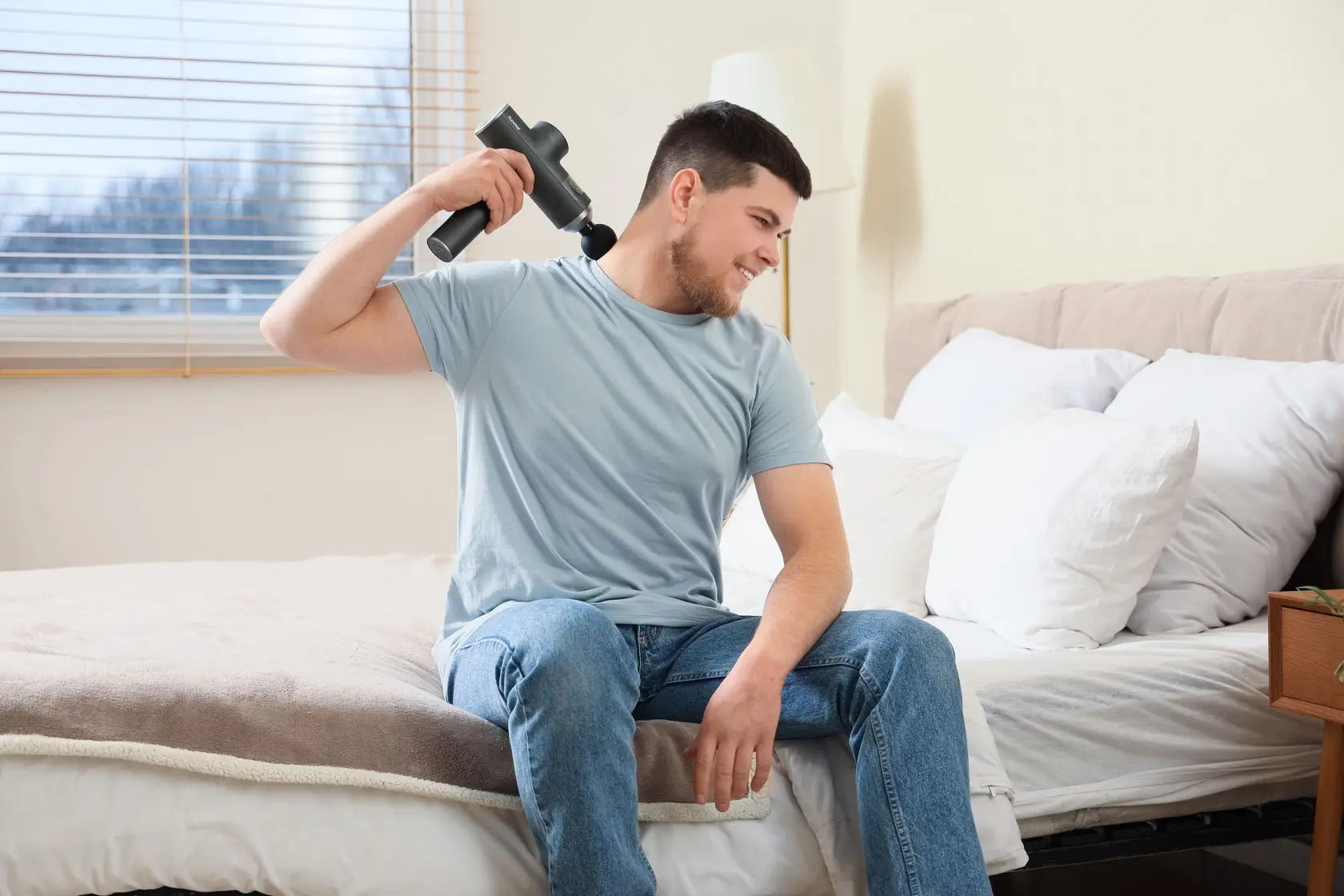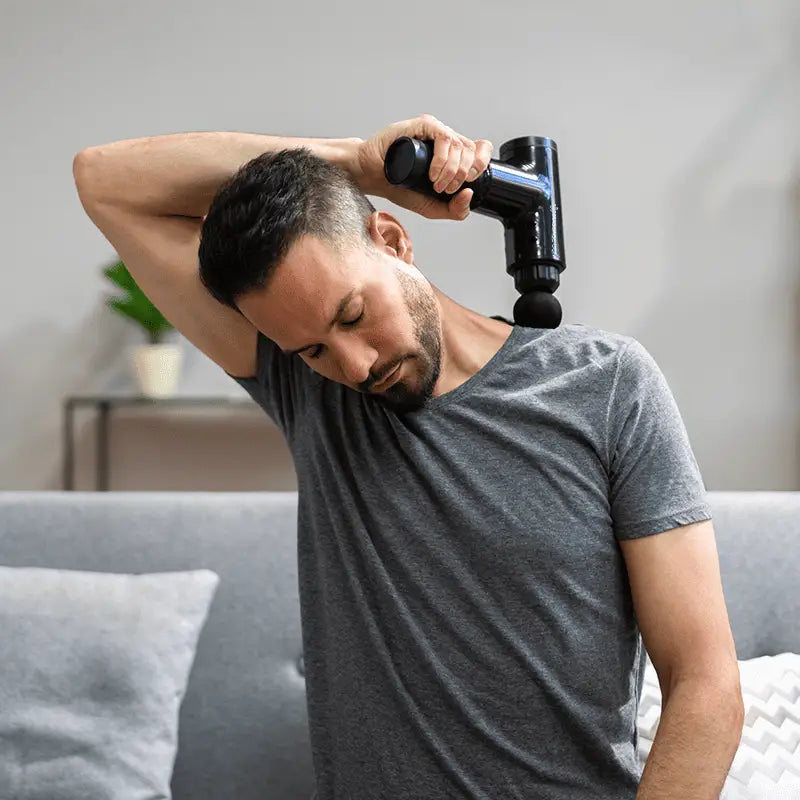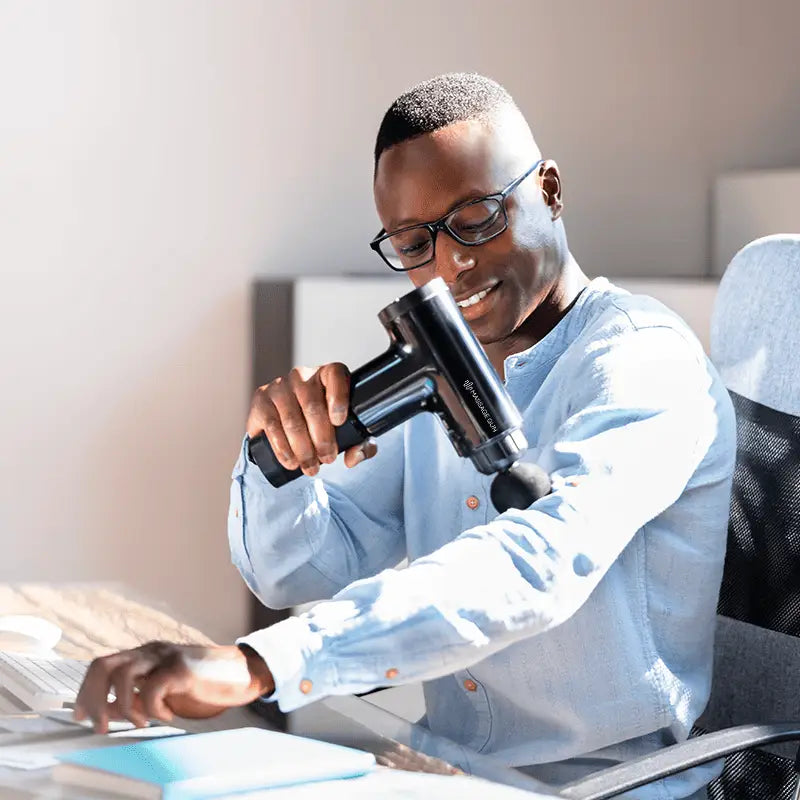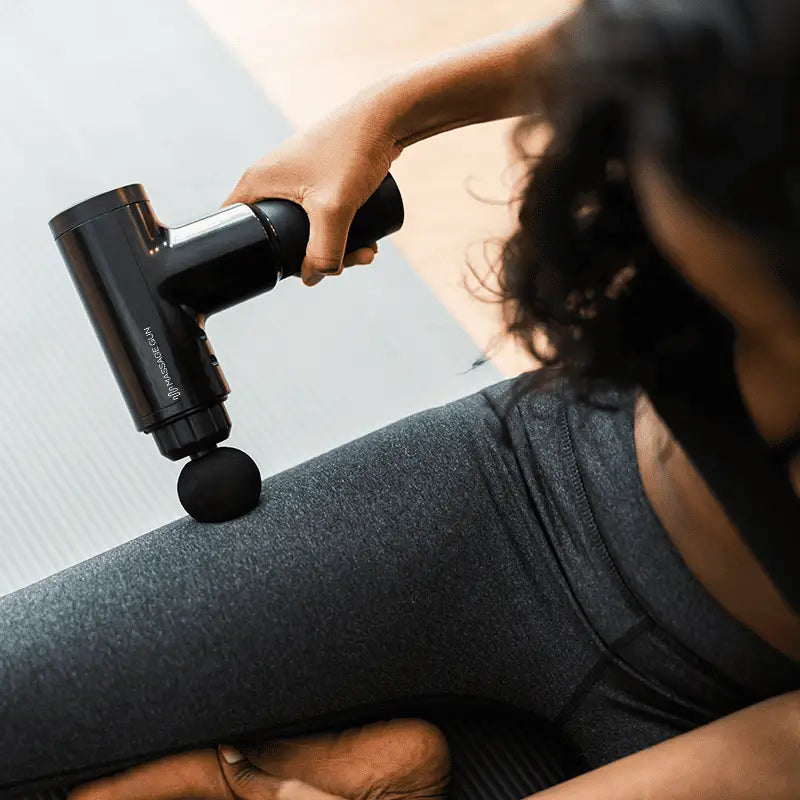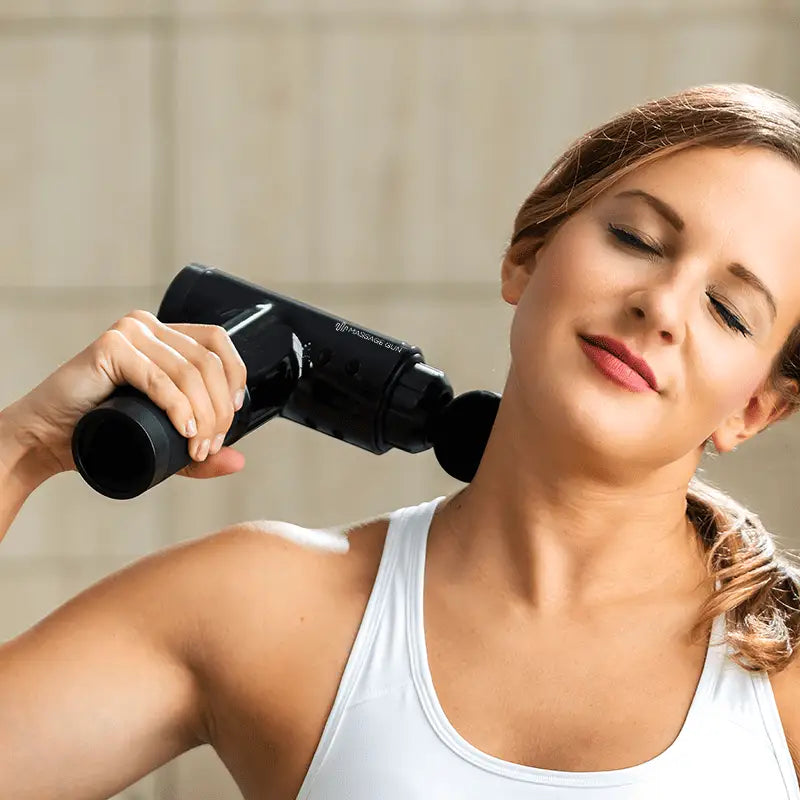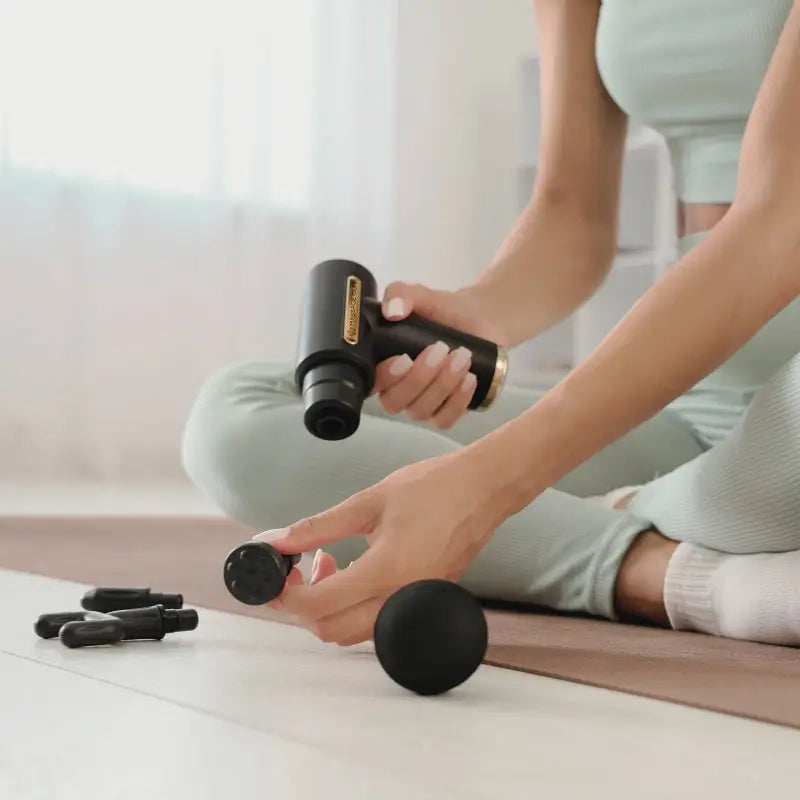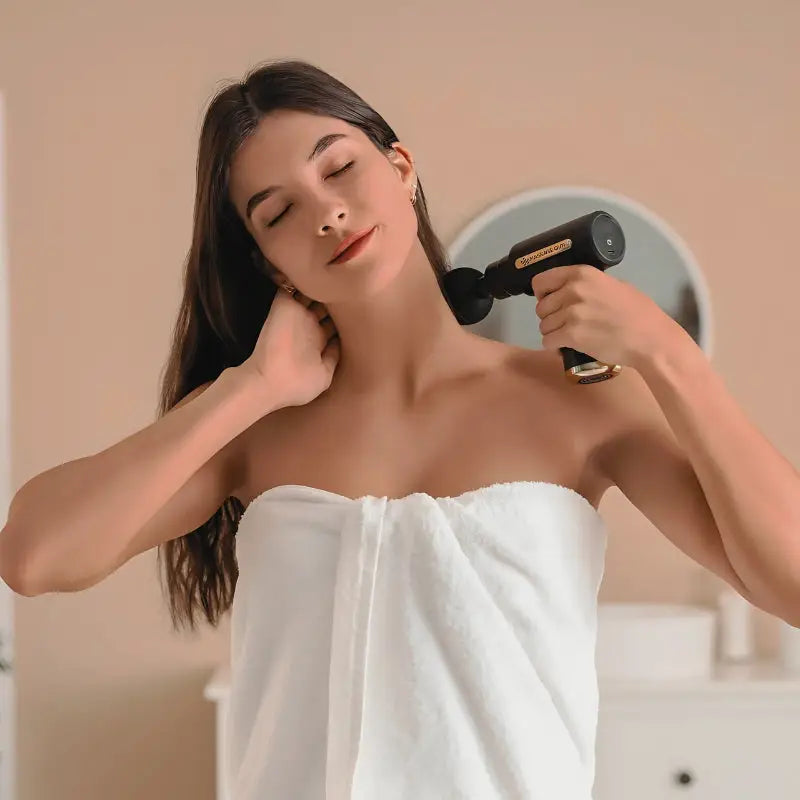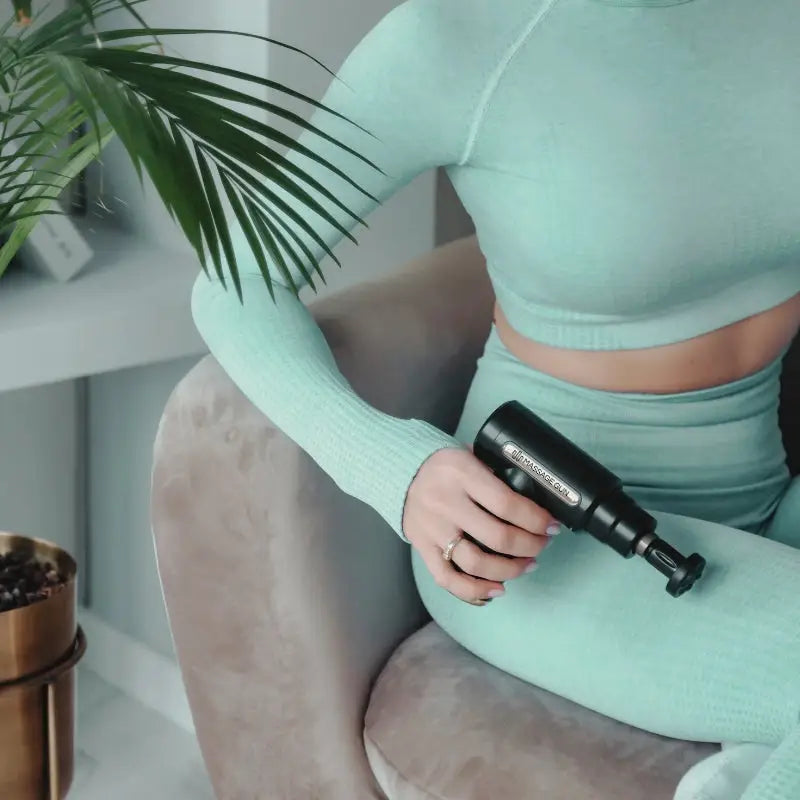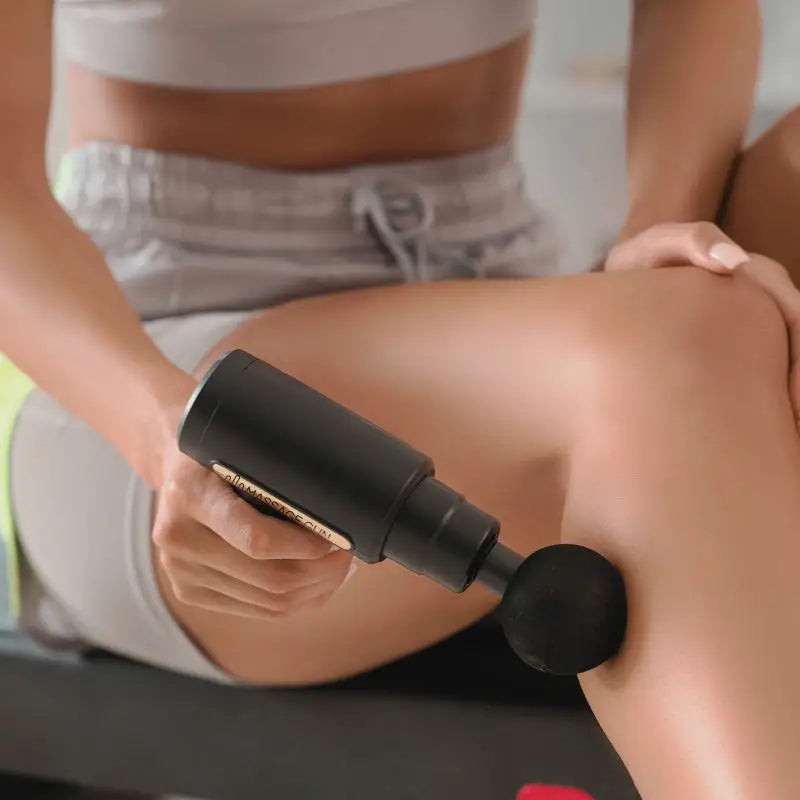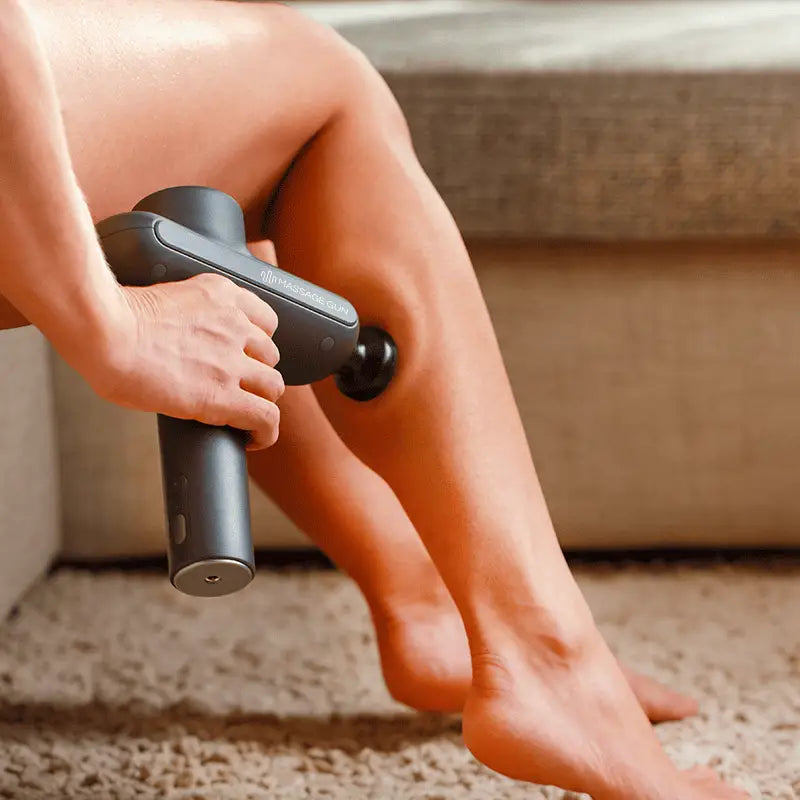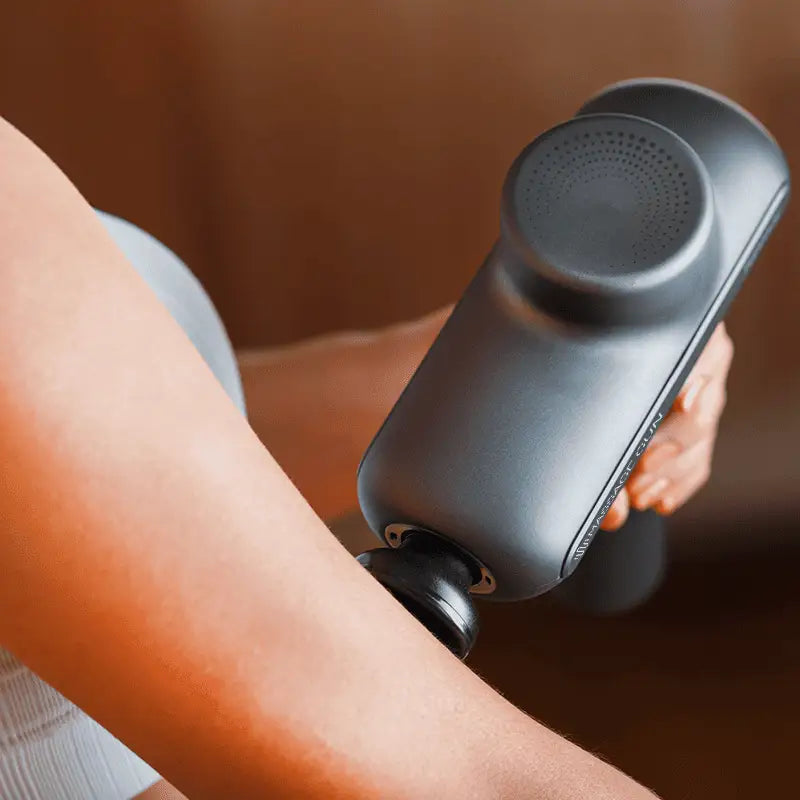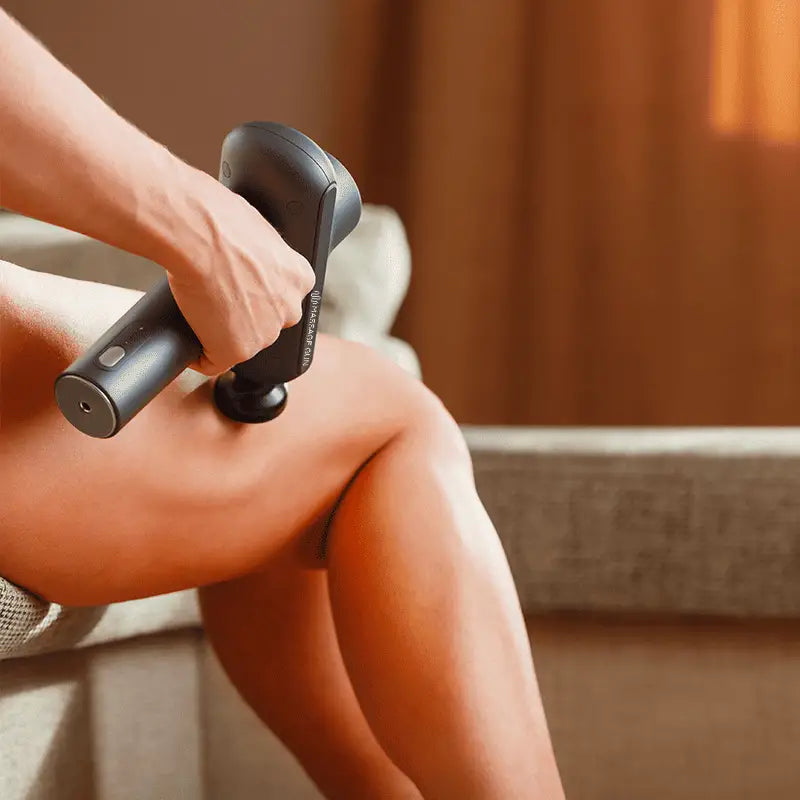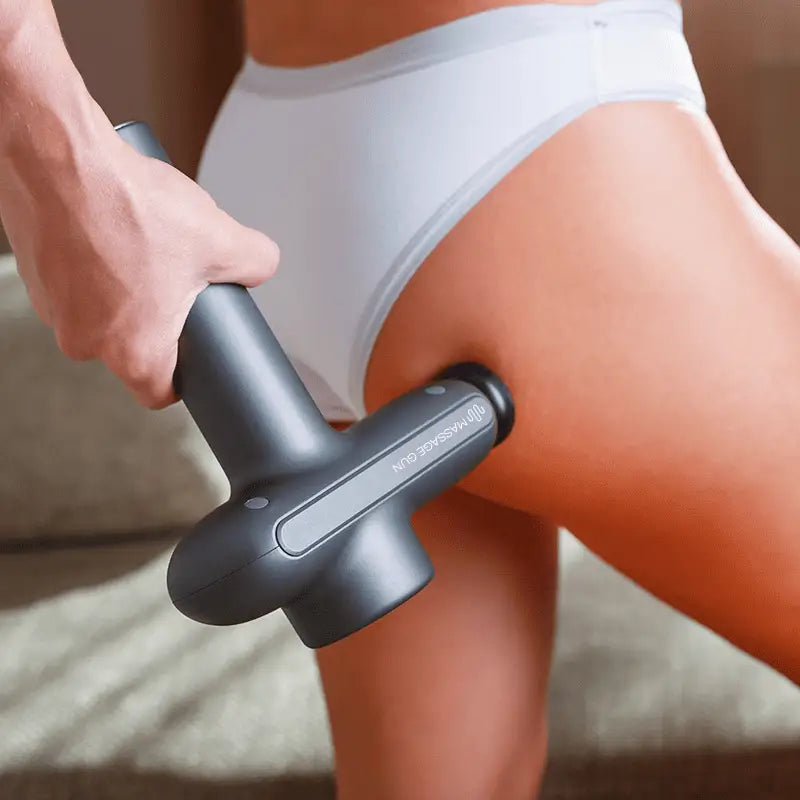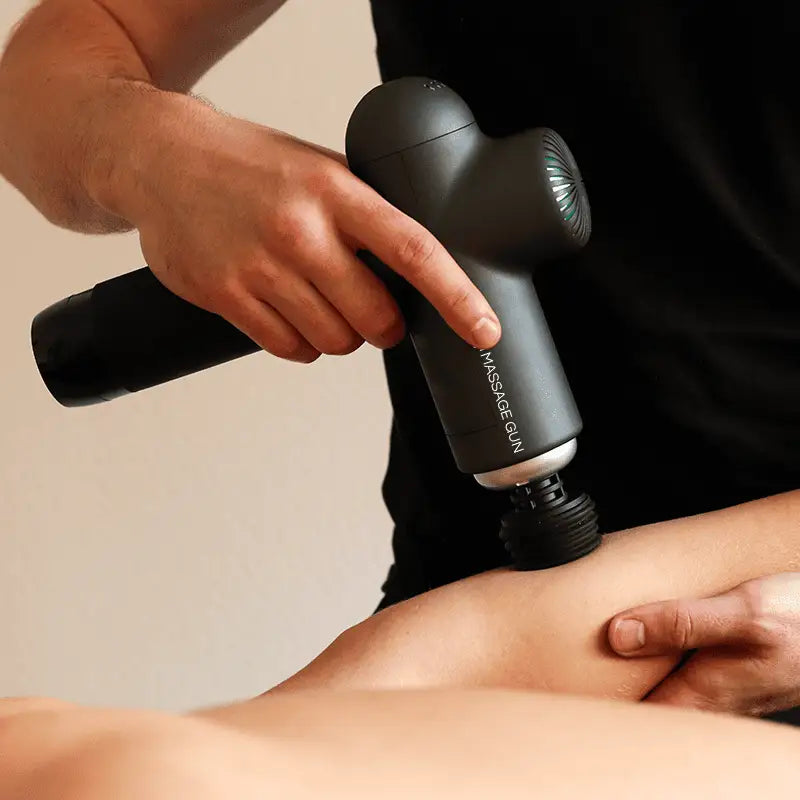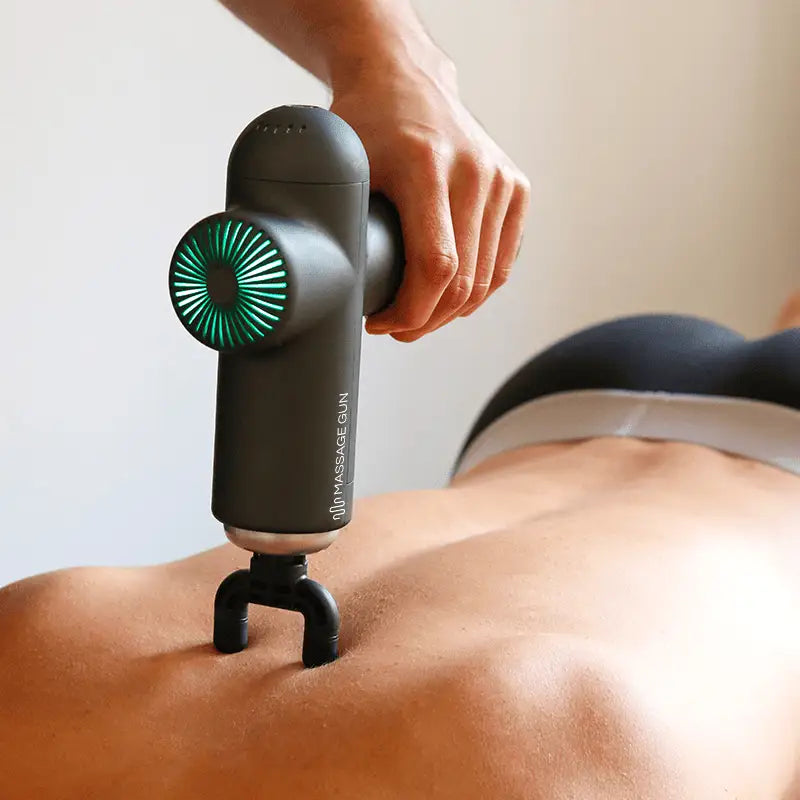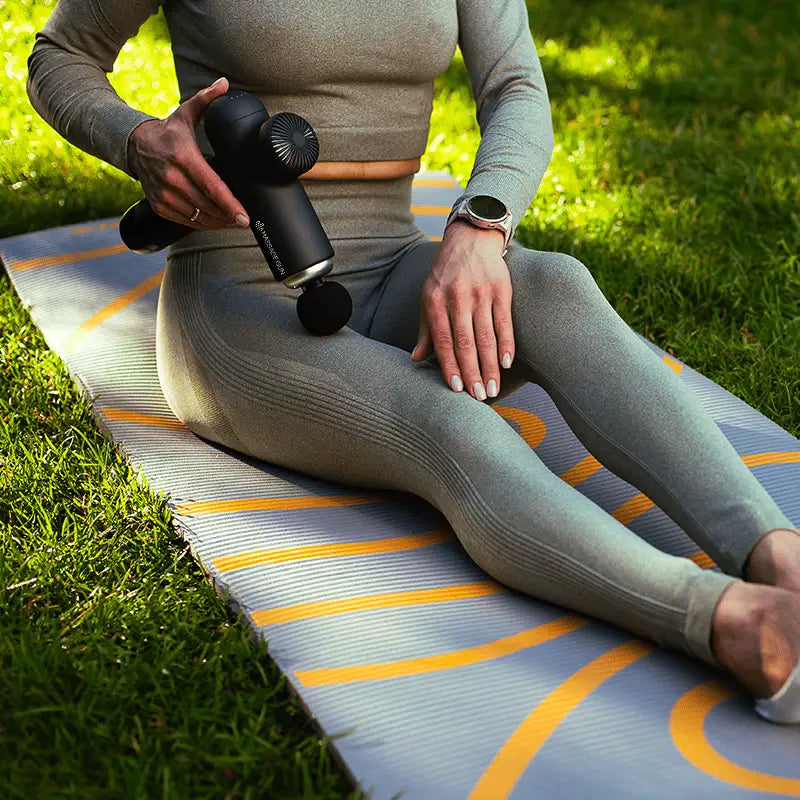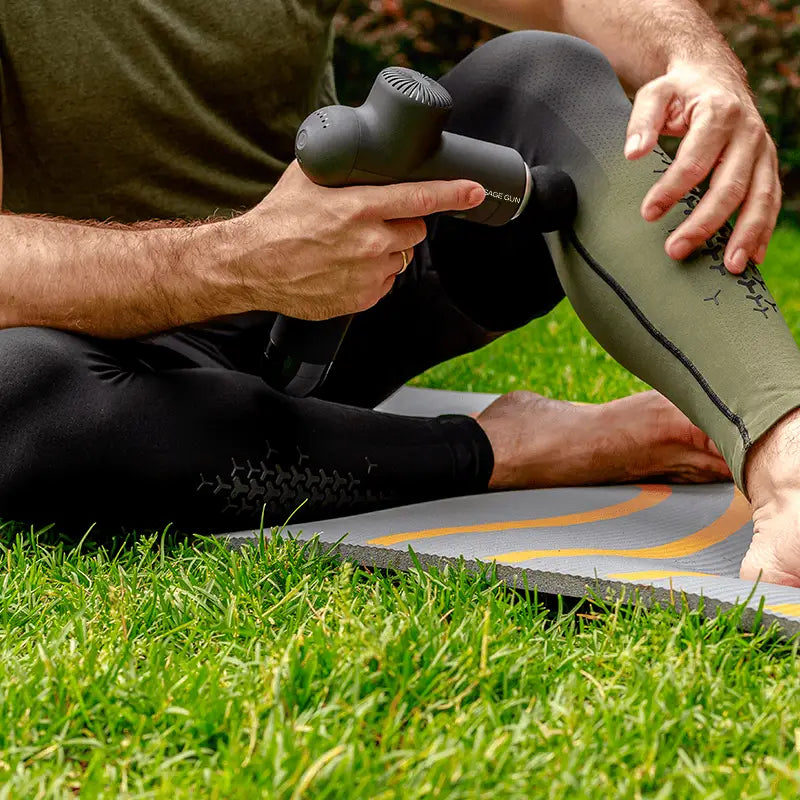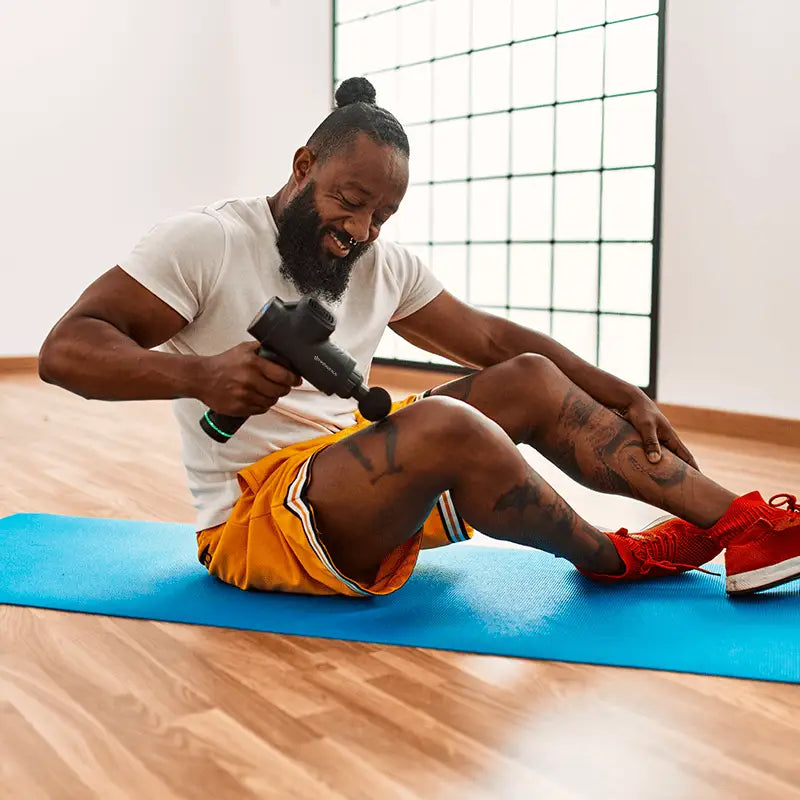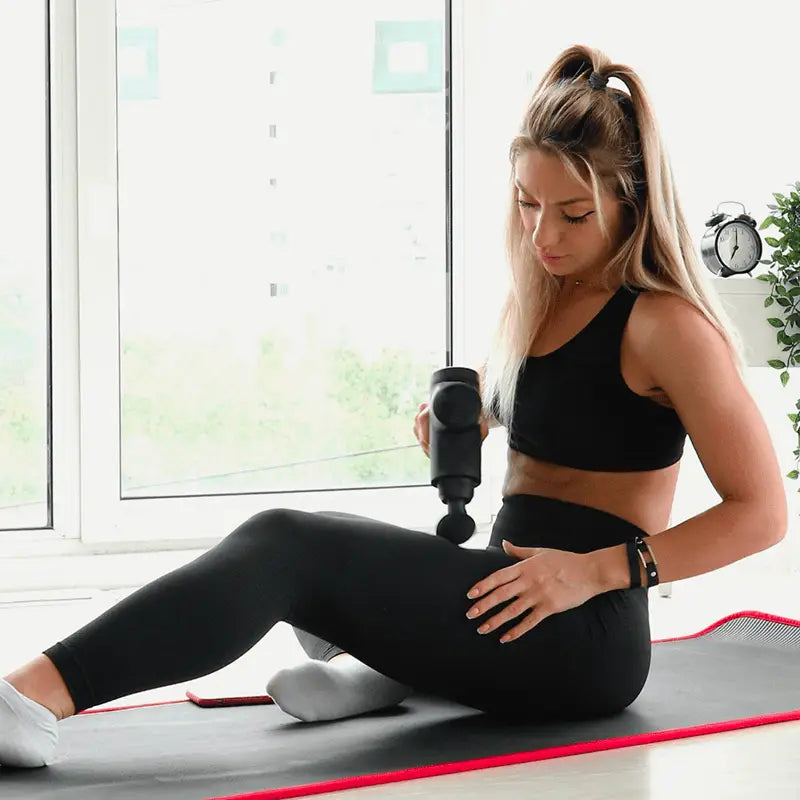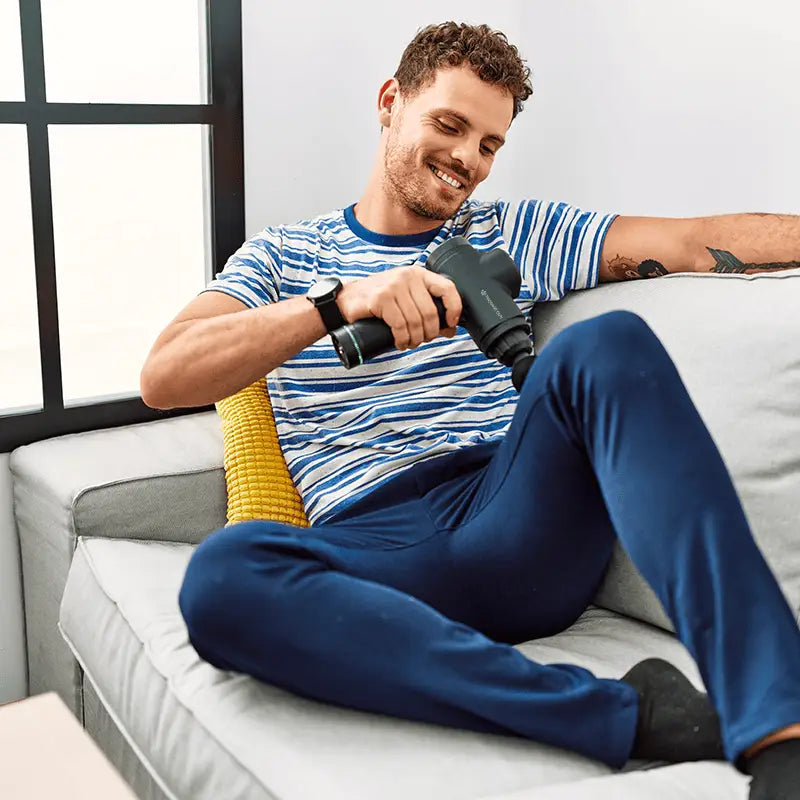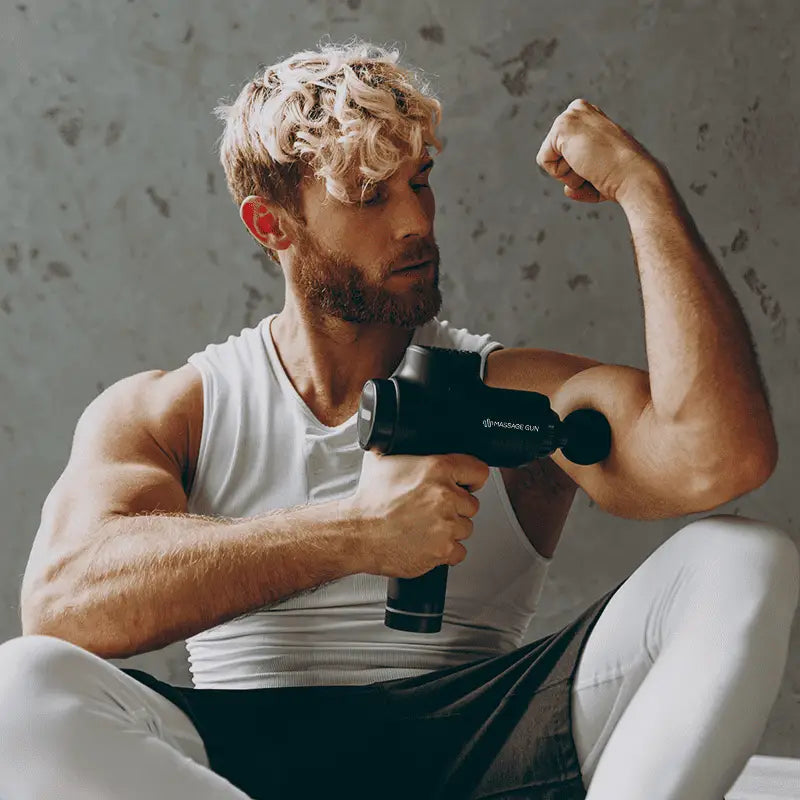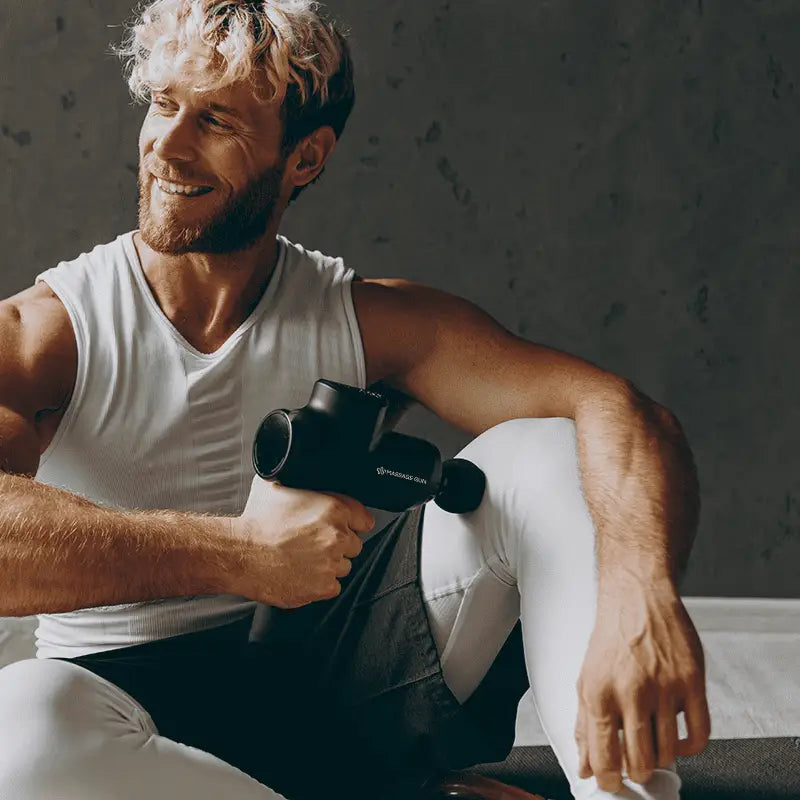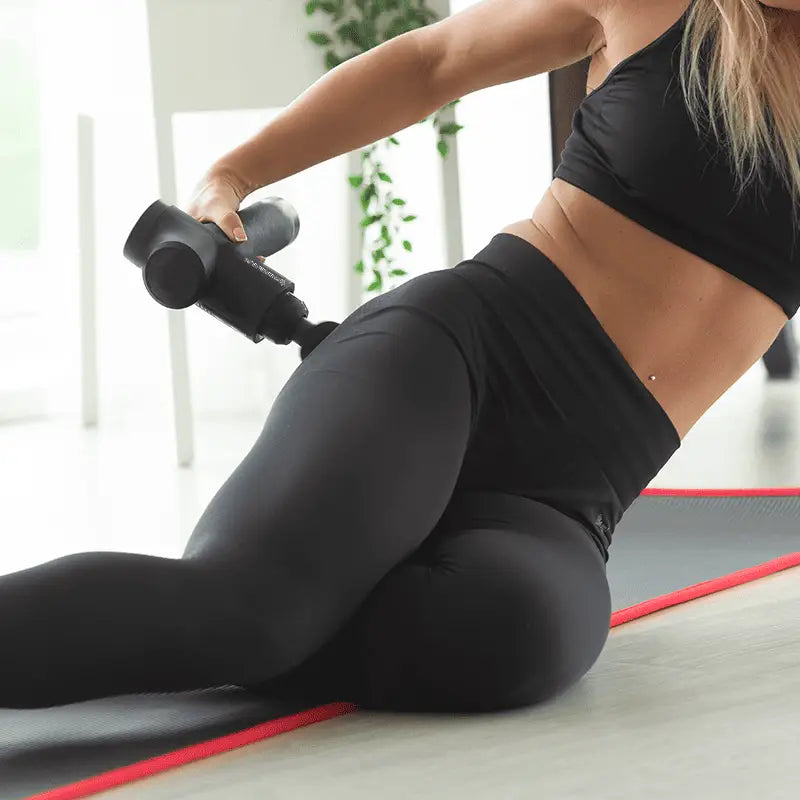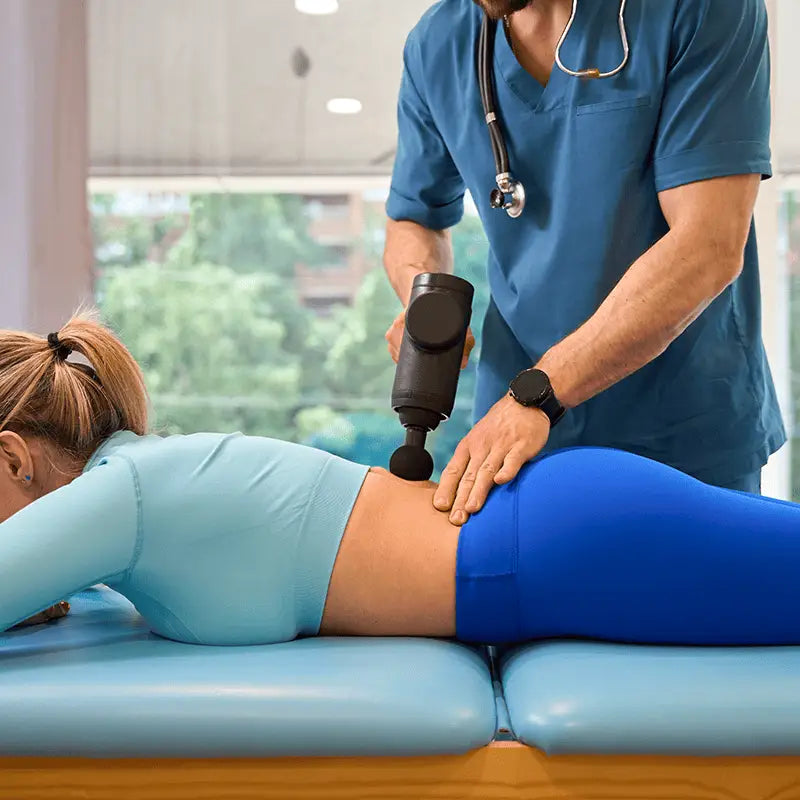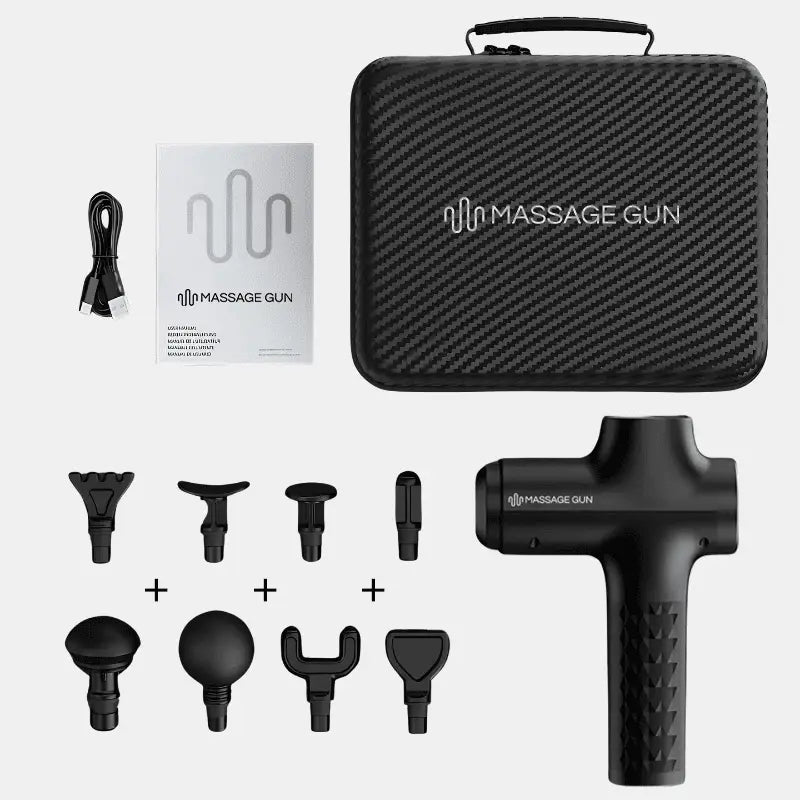El dolor de espalda es un problema común para muchas personas, ya sea por mala postura, largas horas en un escritorio, o actividad física intensa. Un Massage Gun puede ser una herramienta altamente efectiva para aliviar la tensión muscular y promover la relajación.
En esta guía, explicaremos cómo usar un Massage Gun de manera adecuada para aliviar el dolor de espalda, incluyendo técnicas específicas para diferentes grupos musculares.
Esta terapia de percusión puede ser una excelente forma de tratar músculos adoloridos, aliviar la tensión y mejorar la movilidad, especialmente para aquellos que experimentan sensación de rigidez y tensión muscular.
Beneficios de usar un Massage Gun en tu espalda
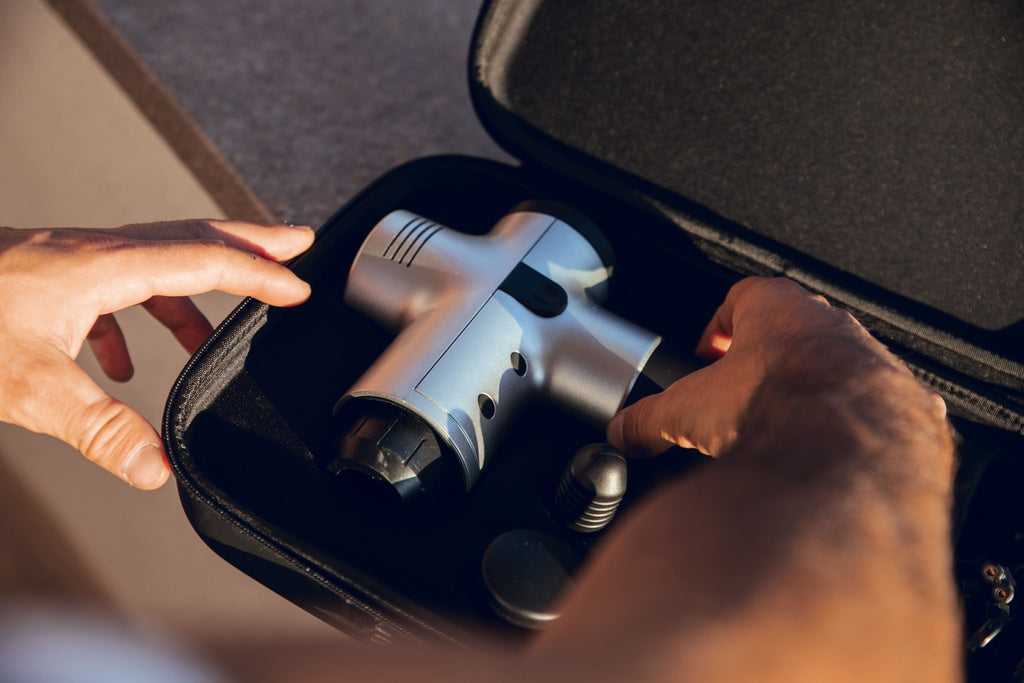
Usar un Massage Gun para el dolor el alivio ofrece numerosos beneficios. La pistola usa ráfagas de presión y vibración para estimular la circulación sanguínea, reducir la inflamación y mejorar la recuperación muscular.
El masaje de percusión está diseñado para enfocar músculos específicos, ayudando a aliviar el dolor y la tensión muscular después de un entrenamiento o actividades diarias. Los estudios revisados en el Journal of Sports sugieren que la terapia de percusión puede mejorar el rango de movimiento y el rendimiento muscular.
Incorporar la terapia con Massage Gun en tu rutina también puede reducir la rigidez, facilitando el ejercicio físico y mejorando la salud muscular en general.
¿Cómo usar correctamente un Massage Gun en tu espalda?
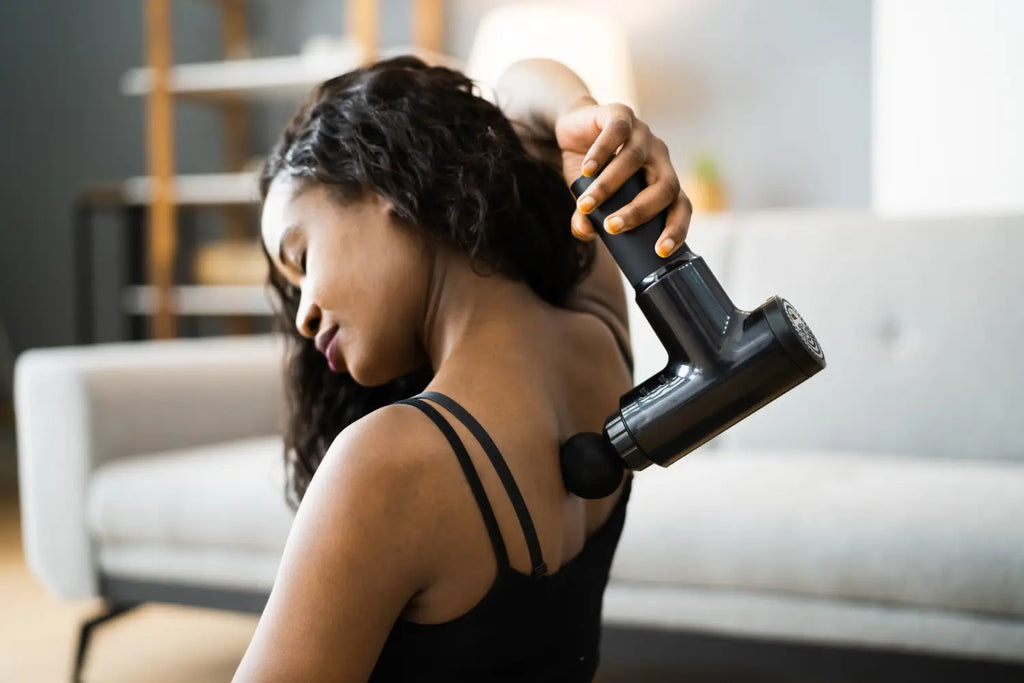
Preparación antes de usar un Massage Gun
Antes de comenzar tu sesión con Massage Gun, asegúrate de estar cómodo, ya sea sentado o acostado. Elige un configuración de velocidad baja al principio y selecciona el cabezal adecuado para tus necesidades, como un cabezal plano para grupos musculares grandes o un cabezal de bala para áreas más precisas.
Esto te ayudará a controlar la intensidad y evitar sobrecargar músculos sensibles. Siempre verifica los ajustes del dispositivo para asegurarte de que esté ajustado correctamente para evitar causar lesiones. Aumenta lentamente la velocidad a medida que tus músculos se relajan y presta atención a cómo responde tu cuerpo durante la sesión.
Instrucciones paso a paso para la parte baja y alta de la espalda
Al usar el Massage Gun en tu espalda, concéntrate en las áreas baja y alta. Comienza aplicando una presión suave sobre los músculos más grandes, como el latissimus dorsi y trapecio. Evita la columna y enfócate en áreas de tejido blando, masajeando en movimientos lentos y controlados.
Para la parte baja de la espalda, usa un cabezal de pelota para cubrir áreas más amplias y aumenta gradualmente la velocidad a medida que mueves la pistola. Mantén tu sesión con Massage Gun breve, alrededor de 10-20 minutos, centrándote en la recuperación muscular y reducción de inflamación.
Esta técnica puede aliviar la rigidez, el dolor y las molestias, especialmente después de actividades físicas.
Usando un compañero para áreas difíciles de alcanzar
Aunque es posible usar el Massage Gun por tu cuenta, contar con un compañero puede ayudar con áreas difíciles como la parte superior de la espalda y el cuello. Un compañero puede dirigir su atención a nudos musculares específicos y áreas tensas de manera más efectiva, aplicando la cantidad justa de presión.
Si no tienes un compañero, usar una pared o una silla para apoyo puede ayudarte a masajear tu espalda de manera segura. Asegúrate de que tu compañero conozca la técnica correcta para evitar lesiones y obtener resultados óptimos.
Las sesiones de masaje asistidas por un compañero pueden ser especialmente útiles para abordar dolor muscular profundo y áreas rígidas que de otra forma serían difíciles de alcanzar.
Duración y frecuencia óptimas
Para evitar sobrecargar tus músculos, limita cada sesión a 10-20 minutos por día, centrándote en aliviar la tensión muscular. Dependiendo de la gravedad de tu dolor, puedes usar la pistola 2-3 veces por semana.
Esto ayudará a mejorar la recuperación muscular y reducir la posible tensión o dolor. Es esencial escuchar a tu cuerpo: si sientes incomodidad, reduce la intensidad o detén la sesión. Un fisioterapeuta puede ofrecer orientación si no estás seguro de con qué frecuencia usar el Massage Gun para tu condición específica.
Seleccionar el Massage Gun y los accesorios adecuados
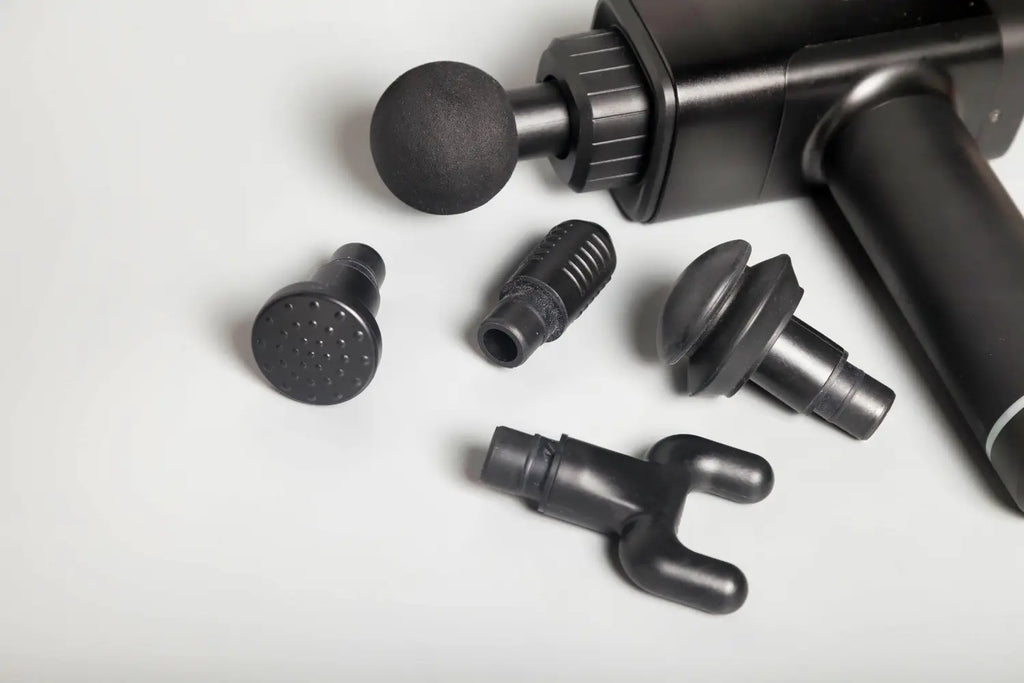
Elegir el Massage Gun correcto es clave para una terapia efectiva. Busca pistolas con ajustes de velocidad ajustables para personalizar tu experiencia, desde una terapia suave de vibración hasta un masaje de tejidos profundos.
El tipo de accesorio también desempeña un papel crucial: los cabezales planos son ideales para tejidos blandos, mientras los cabezales de bala son mejores para áreas más focalizadas. Los grupos musculares grandes pueden beneficiarse de accesorios de pelota, que ofrecen mayor cobertura.
Los dispositivos diseñados con mangos ergonómicos son más fáciles de usar durante sesiones prolongadas, evitando la tensión en las manos. Siempre revisa las opiniones para asegurarte de que la pistola funcione bien en términos de durabilidad y eficacia.
¿Cuándo no usar un Massage Gun en tu espalda?
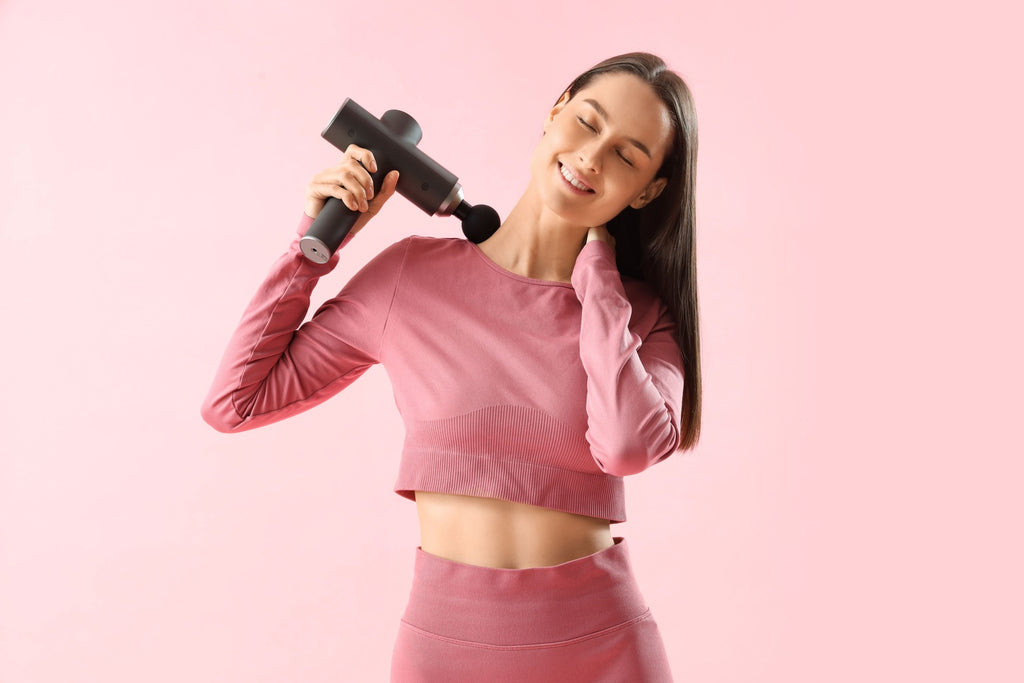
Precauciones clave a tomar
Aunque las pistolas de masaje son excelentes herramientas para la recuperación muscular, hay casos en los que no deben usarse. Si sufres una lesión grave en la espalda, problemas en la columna vertebral, o condiciones crónicas como osteoporosis, consulta a un profesional de la salud antes de comenzar la terapia con Massage Gun.
Evita usar un Massage Gun en áreas con inflamación o hinchazón, ya que esto podría empeorar la lesión. Es crucial ser consciente de tu condición física y evitar aplicar demasiada presión en áreas sensibles. Si no estás seguro, lo mejor es consultar a un quiropráctico o fisioterapeuta antes de usar el dispositivo.
Errores comunes a evitar
Un error común que comete la gente es aplicar demasiada presión durante su sesión con Massage Gun. Aunque parezca que más presión proporciona mejor alivio, esto puede causar daño muscular o incrementar el dolor. Otro error es permanecer demasiado tiempo en una misma zona.
Los pistolas de masaje deben usarse en ráfagas cortas y controladas para evitar sobreestimular el tejido. Finalmente, no ajustar adecuadamente los ajustes de velocidad puede causar molestias, así que siempre empieza en la configuración más baja y súbela gradualmente según sea necesario.
¿Cuándo acudir al médico?
Aunque las pistolas de masaje pueden proporcionar un alivio de dolor significativo, hay momentos en los que es imprescindible buscar atención médica. Si el dolor persiste o empeora después de usar un Massage Gun, podrías estar enfrentando un problema más grave, como una hernia discal o daño nervioso.
En tales casos, detén el uso del dispositivo y consulta a un proveedor de salud inmediatamente. Dolor persistente, hormigueo, o entumecimiento en la espalda o las piernas podrían indicar un problema más grave, y continuar usando un Massage Gun sin la orientación adecuada podría agravar la condición.
Combinar la terapia con Massage Gun con otros tratamientos
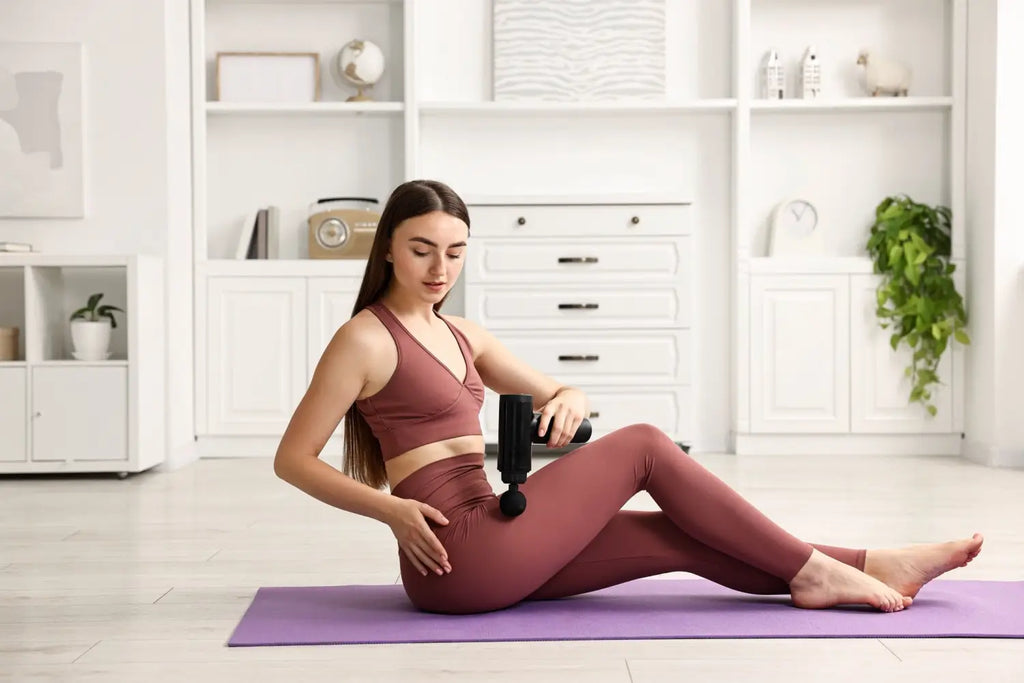
La terapia con Massage Gun puede ser aún más efectiva si se combina con otros tratamientos. Incorporar ejercicios de estiramiento antes y después de la sesión puede ayudar a prevenir la tensión y mejorar la flexibilidad. El rodillo de espuma es otro método excelente para mejorar la recuperación muscular, especialmente para grupos musculares grandes como las piernas y las caderas.
Agregar terapia de vibración a tu rutina, como alternar entre un Massage Gun y un rodillo de espuma, puede estimular la circulación sanguínea y reducir la inflamación más rápidamente. Siempre considera incluir estos tratamientos complementarios para maximizar los beneficios de tus sesiones de terapia de masaje.
Técnicas innovadoras de automasaje usando una pared o silla
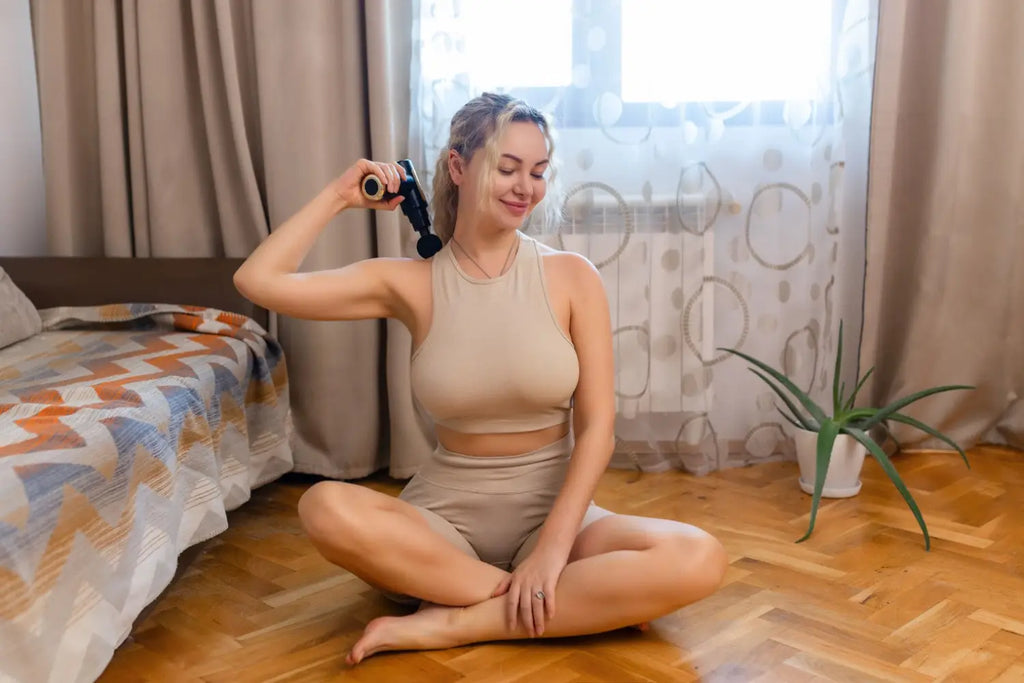
Si no tienes un socio para ayudarte con tu terapia con Massage Gun, aún puedes realizar técnicas efectivas de automasaje usando una pared o una silla. Apoyándote contra una pared, puedes mantener mejor control sobre la Massage Gun’s presión y posición, permitiéndote enfocar en áreas problemáticas específicas.
Una silla puede ayudarte a apoyar tu espalda mientras alcanzas zonas bajas. Esto es especialmente útil para personas que tienen dificultad para alcanzar ciertas áreas de su espalda. Estas técnicas de bricolaje facilitan incorporar la terapia con Massage Gun en tu rutina diaria.
Haciendo que la terapia con Massage Gun sea parte regular de tu rutina de bienestar
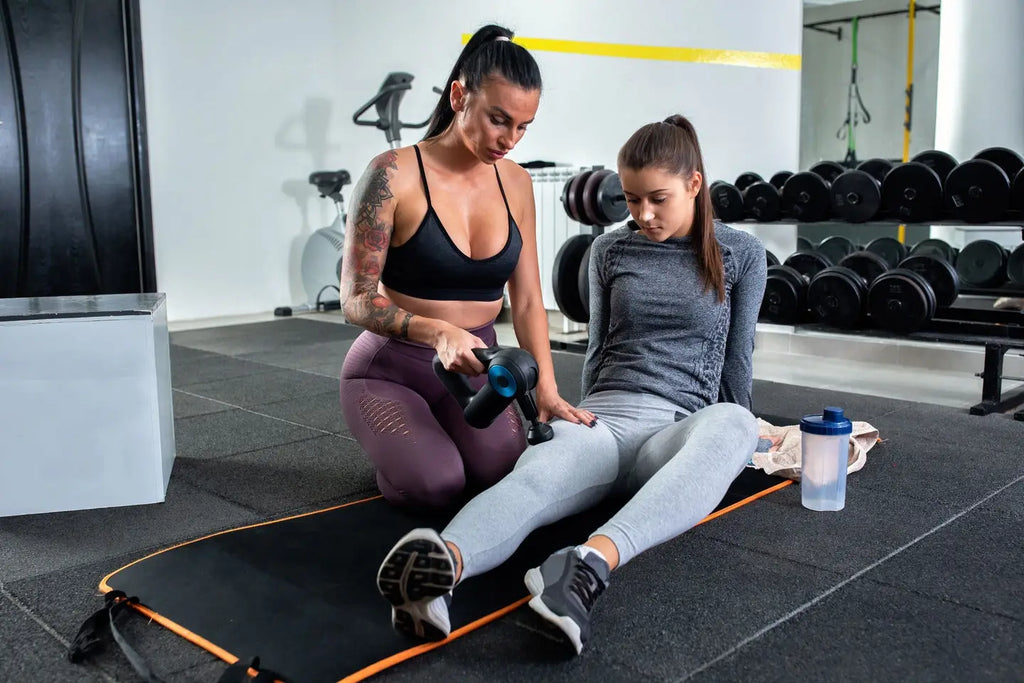
Massage Gun debe ser parte de tu rutina de bienestar para mejorar la salud muscular en general y prevenir molestias futuras. Utilizar el Massage Gun después del ejercicio físico o un día largo puede ayudar a aliviar tensiones y mejorar tu rango de movimiento.
Es importante aumentar progresivamente la velocidad y la intensidad a medida que tus músculos se adapten al tratamiento. Siempre consulta con profesionales de la salud como fisioterapeutas o quiroprácticos para obtener orientación sobre cómo optimizar tus sesiones de masaje y garantizar un uso seguro.
Preguntas frecuentes
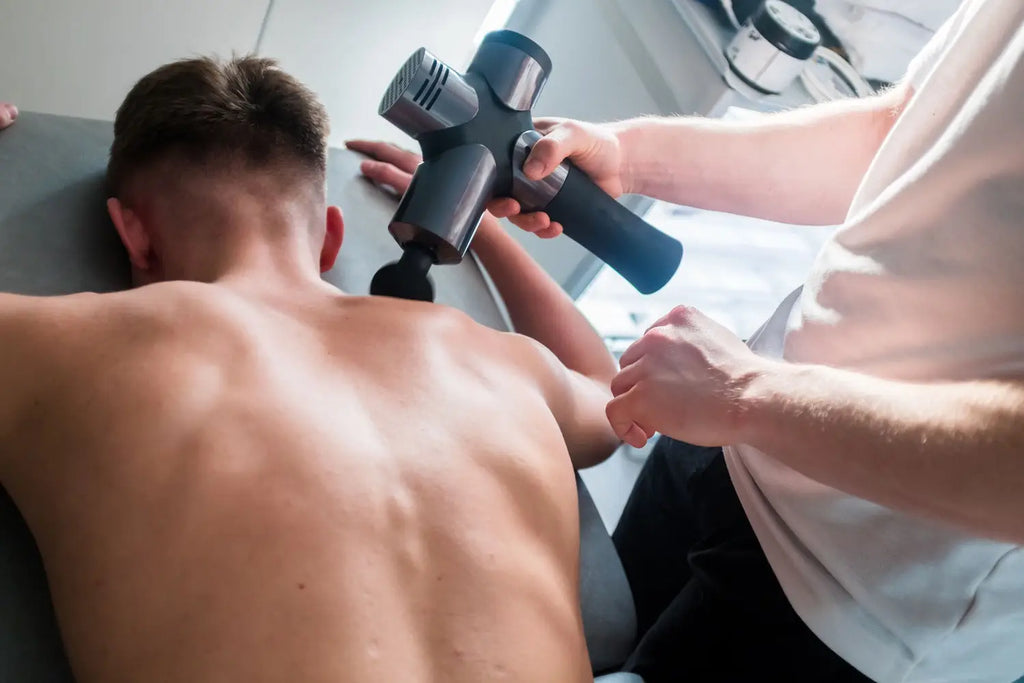
1. ¿Cómo se usa un Massage Gun en la espalda?
Para aprender a usar un Massage Gun en la espalda correctamente, comienza seleccionando el accesorio de cabezal de masaje adecuado según la zona que deseas tratar. Por ejemplo, usa un accesorio de pelota para grupos musculares grandes.
Configura la pistola en su velocidad más baja y aplica una presión suave, evitando la columna. Mueve lentamente la pistola sobre los músculos, enfocándote en áreas de tensión o dolor muscular. Para lugares difíciles de alcanzar, como el cuello, considera que otra persona te ayude.
También puedes tratar la rigidez muscular aumentando gradualmente la velocidad. Para más detalles, mira este video que demuestra la técnica correcta para el masaje de espalda. Si eres nuevo en la terapia de percusión, es fundamental seguir los pasos adecuados para evitar lesiones.
2. ¿Un Massage Gun puede ayudar a aliviar el dolor de espalda?
Sí, las pistolas de masaje para el dolor son muy efectivas para aliviar molestias y rigidez en la espalda. Aplicando masaje de percusión, estos dispositivos ayudan a aumentar la circulación sanguínea, relajar los músculos tensos y reducir la inflamación.
Son particularmente beneficiosos para quienes se recuperan de levantar pesas u otras actividades intensas. Según expertos, las pistolas de masaje pueden ser una valiosa adición a las rutinas de masaje tradicionales, brindando una recuperación más rápida.
Una revisión reciente sobre los beneficios de la terapia de masaje en entornos deportivos confirma que las pistolas de masaje pueden ayudar a aliviar el dolor y promover la salud muscular a largo plazo. Para más información, lee este artículo que compara las pistolas de masaje con técnicas tradicionales.
3. ¿Es seguro usar un Massage Gun en la parte baja de la espalda?
Sí, generalmente es seguro usar un Massage Gun en la parte baja de la espalda cuando se hace correctamente. La precaución es clave: comienza en la configuración más baja y evita aplicar demasiada presión directamente sobre la columna. Concéntrate en los músculos circundantes en su lugar.
Según Hinge Health y otros expertos en terapia física, usar un Massage Gun puede tratar eficazmente las molestias en la parte baja de la espalda. Es importante tener en cuenta la seguridad y seguir una guía paso a paso para no agravar condiciones existentes.
Los expertos recomiendan limitar tu sesión a 10-20 minutos para obtener mejores resultados. Para obtener consejos adicionales de seguridad, consulta a un fisioterapeuta si tienes dudas sobre tu técnica.
4. ¿Cuál es el mejor accesorio de Massage Gun para la espalda?
Los mejores cabezales para tu espalda dependen del tipo de masaje que necesitas. Para grupos musculares amplios como el dorsal ancho, se recomienda un accesorio de pelota.
Para trabajos más focalizados, como aliviar molestias cerca del cuello o la parte superior de la espalda, un cabezal de bala puede ser muy útil. Los beneficios de masajear con accesorios adecuados incluyen mayor movilidad, reducción del dolor muscular y mejor recuperación después de levantar pesas.
Los expertos también recomiendan experimentar con diferentes cabezales para encontrar el que mejor funcione para tu cuerpo. Para obtener orientación adicional, revisa esta evaluación de las mejores pistolas de masaje y sus cabezales para grupos musculares específicos.
5. ¿Cuánto tiempo debo usar un Massage Gun en la espalda?
Al usar un Massage Gun en tu espalda, es importante aplicar la técnica correcta para evitar lesiones. Se recomienda usar el dispositivo durante 10-20 minutos por sesión, enfocándose en cada grupo muscular durante aproximadamente 10-20 segundos.
Luego, asegúrate de seguir tu rutina posterior, que puede incluir estiramientos suaves u otros ejercicios de recuperación. Las técnicas de recuperación tradicionales, combinadas con masaje de percusión, ofrecen una recuperación más rápida del dolor muscular y rigidez.
Para la seguridad, siempre escucha a tu cuerpo y evita el uso excesivo, especialmente si eres nuevo en el uso de pistolas de masaje para aliviar dolor.
6. ¿Se puede usar un Massage Gun en la parte superior de la espalda y los hombros?
Sí, un Massage Gun puede usarse de manera segura en la parte superior de la espalda y el cuello, pero debes tener precaución adicional. Evita colocar la pistola directamente en áreas óseas y comienza con configuraciones de velocidad baja para reducir el riesgo de lesión. Usa un cabezal de masaje plano o de bala para tratar nudos musculares en los hombros y los trapecios.
Los expertos en fisioterapia recomiendan usar terapia de percusión para aliviar el dolor y la rigidez en estas áreas, especialmente después de actividades intensas como levantar pesas. Recuerda, si tienes dudas sobre usar la pistola en zonas sensibles, consulta a un fisioterapeuta para obtener asesoramiento.
7. ¿Puede un Massage Gun en tu espalda causar lesiones?
Usar un Massage Gun incorrectamente puede provocar lesiones, especialmente si se aplica demasiada presión o si la pistola se usa en áreas sensibles como la columna o el cuello. Siempre comienza en la configuración más baja y aplica la pistola solo en tejido muscular.
Es importante tener precaución y evitar permanecer en un mismo lugar demasiado tiempo. Los expertos en terapia física explican que el uso incorrecto de un Massage Gun puede empeorar lesiones, así que sigue las pautas de seguridad y consulta a un profesional de la salud si tienes dudas.
Para más información, consulta este artículo sobre cómo evitar lesiones con pistolas de masaje para el dolor.
8. ¿Con qué frecuencia debo usar un Massage Gun en mi espalda?
Es seguro usar un Massage Gun en tu espalda 2-3 veces por semana, dependiendo de tu nivel de dolor y rigidez muscular. Para una recuperación más rápida, usa el Massage Gun después de actividades intensas como levantar pesas.
Sin embargo, es importante evitar el uso excesivo; demasiado masaje de percusión puede causar fatiga muscular. Seguir una rutina de recuperación que incluya estiramientos puede mejorar los beneficios del masaje.
Si no estás seguro de con qué frecuencia usar la pistola, consulta a un fisioterapeuta o masajista para recomendaciones personalizadas.
9. ¿Debo usar un Massage Gun antes o después del entrenamiento para aliviar el dolor de espalda?
Puedes usar un Massage Gun tanto antes como después del entrenamiento para aliviar el dolor muscular y mejorar la recuperación. Antes del entrenamiento, la pistola ayuda a calentar los músculos, mejorando el rango de movimiento y previniendo lesiones. Después del entrenamiento, el masaje de percusión ayuda en la recuperación muscular al reducir la tensión y la rigidez.
Según expertos, esto ayuda a una recuperación más rápida y reduce el riesgo de lesiones, especialmente en atletas que hacen levantamiento de pesas u otras actividades de alto impacto. Recuerda siempre usar el Massage Gun en la configuración más baja al principio para aplicarlo correctamente.
10. ¿Puedo usar un Massage Gun si tengo una lesión en la espalda?
Si tienes una lesión en la espalda, es crucial que consulte a un fisioterapeuta o profesional de la terapia física antes de usar un Massage Gun. Aunque la terapia de percusión puede ayudar a aliviar el dolor y la tensión muscular, usarla en una zona lesionada podría empeorar el problema.
Los expertos de Hinge Health enfatizan la importancia de consultar a un proveedor de atención médica para evitar complicaciones. Dependiendo de la gravedad de tu lesión, podrían recomendarte evitar el uso de un Massage Gun por completo o sugerir tratamientos alternativos para una recuperación segura.
Para más detalles, lee esta revisión sobre cómo la terapia de masaje puede impactar a quienes tienen lesiones en la espalda.


